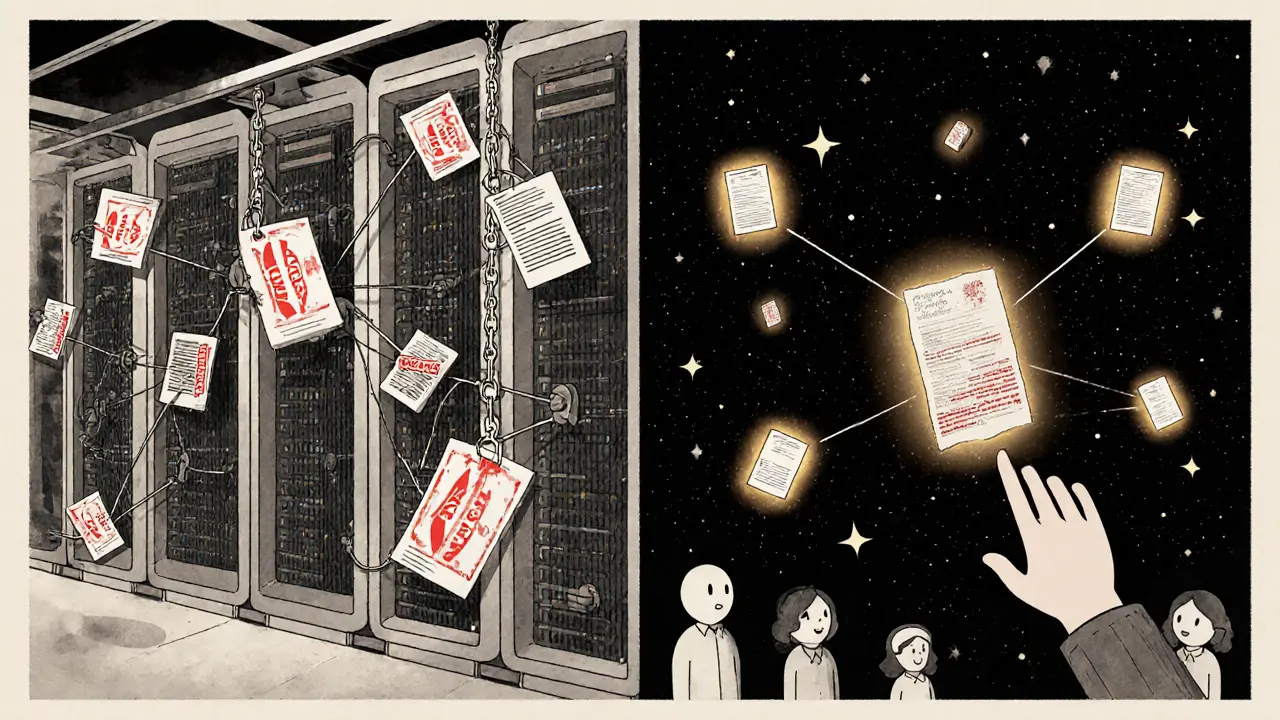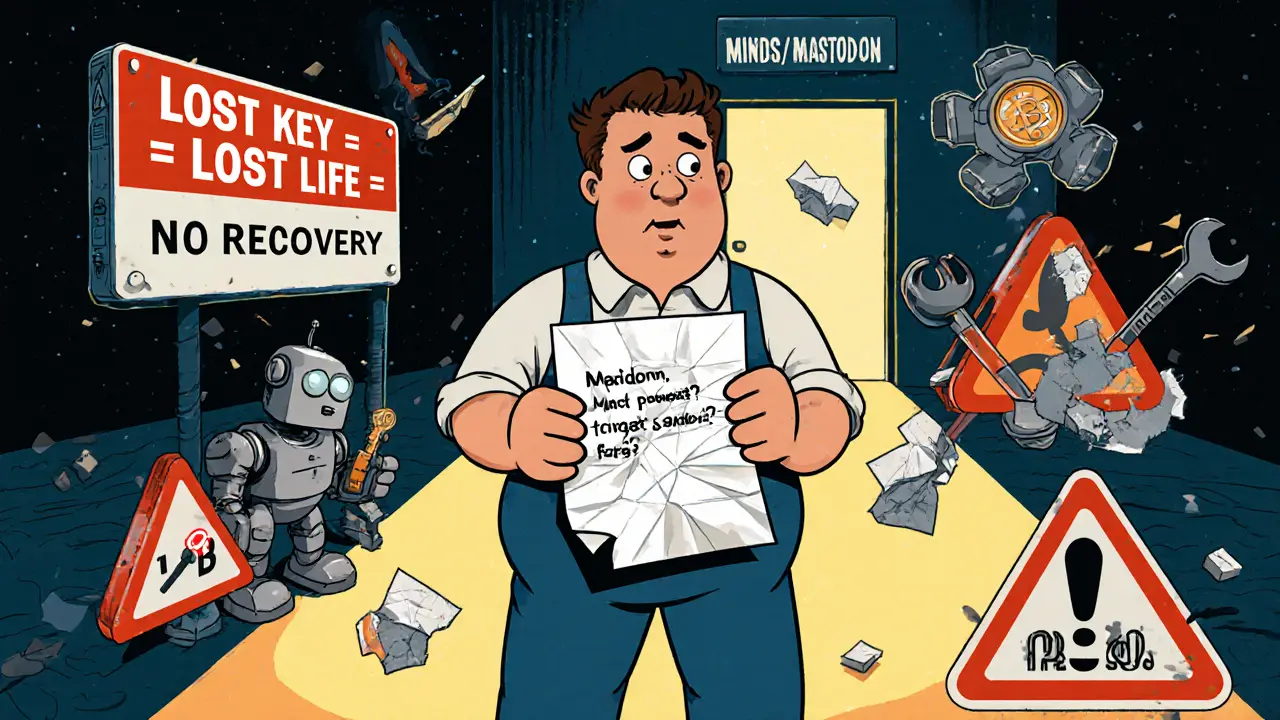User Data Control on Blockchain Social Networks: Take Back Your Digital Identity

Nov, 14 2025
What if you owned your social media data - not a corporation?
Right now, every like, comment, and post you make on Facebook, Instagram, or X is owned by the platform. They sell your attention, track your habits, and can delete your content without warning. But on blockchain social networks, you hold the keys. No middleman. No hidden data deals. Just you, your posts, and your control.
How blockchain social networks work (without the jargon)
Traditional social media runs on big servers owned by companies. Blockchain social networks? They run on thousands of computers around the world. Your posts aren’t stored in one place - they’re split up and saved across a network using tools like IPFS or Filecoin. Your identity is tied to a digital key, not an email or phone number. And every action you take - posting, liking, sharing - is recorded on a public ledger that can’t be changed.
Think of it like sending a letter. On Facebook, you hand it to the post office (the company), and they decide who sees it, when it gets deleted, or if they’ll charge you to reach your friends. On a blockchain network, you seal the letter yourself, write exactly who can open it, and drop it into a public mailbox everyone can see but no one can alter.
Why this matters: Real control, real privacy
On platforms like Minds or Steemit, you decide who sees your data. Want to block an advertiser? One click revokes their access. No appeals. No customer service tickets. No loopholes. According to Pew Research Center’s 2024 survey, 98% of blockchain social networks use end-to-end encryption by default. Compare that to just 42% of mainstream platforms.
And it’s not just about hiding stuff - it’s about ownership. Your profile, your followers, your content - all yours. If you leave the platform, you take everything with you. No one can lock you out. No one can erase your history. Steemit has kept every post since 2016 untouched. That’s not marketing. That’s how the system works.

What’s different from Facebook or Twitter?
Here’s the stark contrast:
- Facebook: Processes 4 million data actions per second. Runs on 30,000 servers. Deletes 1.2 million accounts in one quarter. Owns your data. Can change rules anytime.
- Blockchain network (e.g., Lens Protocol): Handles 1,200 actions per second across 1,000+ nodes. Content is permanent. No single entity can delete it. You control permissions.
Blockchain networks don’t have a CEO who can suddenly ban you for saying the wrong thing. They don’t have a board that sells your data to advertisers. If you lose your private key, you’re locked out - but that’s your problem, not the platform’s. There’s no customer support team to call. There’s no “recover account” button. That’s the trade-off.
Where it falls short - the real problems
Don’t get fooled by hype. Blockchain social networks aren’t perfect. In fact, most are still clunky.
First, media doesn’t work well. High-res photos? Videos? Too expensive to store on-chain. Most platforms limit you to text and low-quality images. Blaize Tech’s 2024 analysis found 78% of these networks can’t handle rich media properly. If you’re used to posting 4K videos on TikTok, you’ll be frustrated.
Second, onboarding is a nightmare. You need to manage a 256-bit private key - a long string of letters and numbers. Lose it? Your account is gone forever. No reset. No email recovery. Peiko’s 2024 study showed 63% of new users need help just to get started. That’s not user-friendly. That’s risky.
Third, features are basic. No algorithmic feed. No trending topics. No easy way to find friends. Mastodon, one of the most popular decentralized networks, has over 1.2 million users - but it’s still mostly used by tech-savvy people who want to escape mainstream platforms, not by casual users looking to connect.
Who’s actually using these platforms?
Most users are crypto natives. Coinmetro’s 2024 data shows 68% of blockchain social media users already own cryptocurrency. The gender split is extreme: 79% are male. These aren’t mainstream platforms yet. They’re niche communities for people who care more about control than convenience.
But that’s changing. After Twitter’s 2023 API changes, 450,000 people moved to mastodon.social - and 89% said they did it for data control. The EU’s Digital Services Act now forces big platforms to let users take their data with them. Blockchain networks already do that by design. That’s a huge advantage.

How to get started - if you’re ready
Here’s what you need to do:
- Choose a platform: Minds, Mastodon, or Steemit are the easiest to start with.
- Download a wallet: MetaMask or Rabby Wallet will help you manage your keys.
- Create your account: You’ll generate a private key. Write it down. On paper. In a safe place.
- Back it up: Seriously. If you lose it, you lose everything.
- Start posting: Your content will be stored on decentralized networks. Your followers will be linked to your key, not your email.
Expect it to take 30-45 minutes just to set up. Most people need help from a friend or YouTube tutorial. Documentation varies wildly - Steemit’s guides are solid. Newer platforms? Not so much.
The future: Hybrid or bust?
Experts don’t think blockchain networks will replace Instagram or TikTok anytime soon. But they might replace the parts we hate most.
Research from the World Economic Forum predicts a hybrid future: blockchain handles your identity and data permissions, while big platforms handle the feed, videos, and ads. You log in with your blockchain key, but see content the same way you do now. That’s the sweet spot.
Companies like Microsoft are already testing this with ION, their decentralized identity system. And new tech like zero-knowledge proofs (coming in 2025) will let you prove you’re you without showing your data at all.
By 2027, Gartner predicts 15% of global social media users will interact mostly through decentralized platforms. That’s not a majority. But it’s enough to force change.
Final thought: Control isn’t free - but it’s worth it
Blockchain social networks aren’t for everyone. They’re slow, confusing, and lack polish. But they’re the only place on the internet where your data doesn’t belong to someone else.
If you’re tired of being the product, if you want to know exactly who sees your words, if you refuse to let a corporation delete your memories - then this is your chance. It’s not easy. But nothing worth having ever is.
The choice isn’t between perfect and imperfect. It’s between control and surrender. And right now, only blockchain networks offer the first.
Can I really own my data on blockchain social networks?
Yes. Unlike Facebook or Twitter, where the platform owns your posts and can delete or monetize them, blockchain networks tie your content to your private key. You control who sees it, when it’s shared, and whether it’s deleted. No company can override your permissions.
What happens if I lose my private key?
You lose access to your account permanently. There’s no “forgot password” button. No customer service can help you. Your posts, followers, and reputation are gone unless you have a backup. That’s why writing your key down on paper and storing it securely is non-negotiable.
Are blockchain social networks faster than Facebook?
No, not by a long shot. Facebook loads posts instantly. Blockchain networks take 15-30 seconds per action on Ethereum-based systems, and even faster (3 seconds) on chains like Steem. That’s fine for text posts, but terrible for real-time interaction. They’re not built for speed - they’re built for ownership.
Can I post videos on blockchain social networks?
Technically yes, but practically, no. Storing video files on-chain is too expensive. Most platforms limit you to low-res images and text. Some use external storage like IPFS, but that still requires technical know-how. For now, if you want to post high-quality video, you’ll still need mainstream platforms.
Is it worth switching from Instagram to a blockchain network?
Only if you prioritize privacy over convenience. You’ll lose features like algorithms, stories, Reels, and easy friend-finding. But you’ll gain full control over your data. For many, it’s not about replacing Instagram - it’s about having a private space where your content isn’t owned by a corporation.
Are blockchain social networks legal?
Yes. They’re fully legal. In fact, they’re better positioned for regulations like GDPR and the EU’s Digital Services Act because they naturally support data portability and user consent. Regulators are starting to see them as solutions, not threats.
Do I need to know coding to use these platforms?
No. You don’t need to code. But you do need to understand basic concepts like private keys, wallets, and permissions. Tools like MetaMask have made this much easier. Still, most users need help during setup - it’s not as simple as signing up with Google.
Can I make money on blockchain social networks?
Yes - but differently. On Steemit and Lens Protocol, you earn crypto tokens for posting, commenting, and curating content. It’s not like ad revenue. It’s a reward system based on community engagement. Some creators earn enough to make it a side income, but it’s not a replacement for YouTube or TikTok monetization yet.